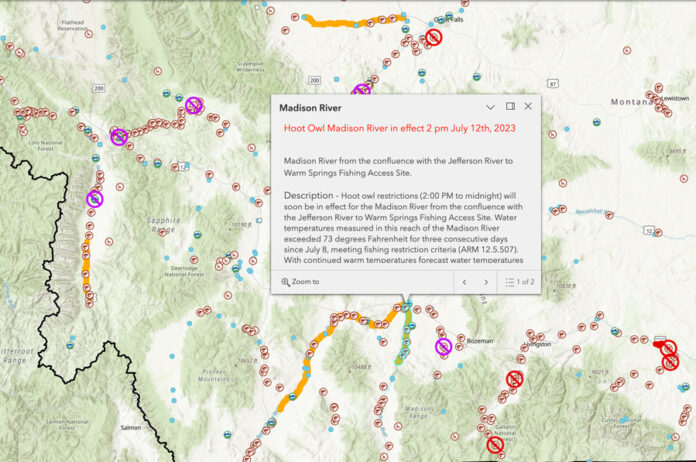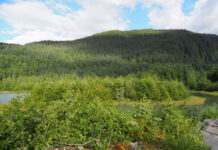Welcome to the latest installment of the Wednesday Wake-Up Call, a roundup of the most pressing conservation issues important to anglers. Working with our friends at Trout Unlimited, Backcountry Hunters & Anglers, the Theodore Roosevelt Conservation Partnership, The Everglades Foundation, Captains for Clean Water, VoteWater.org, and Conservation Hawks (among others), we’ll make sure you’ve got the information you need to understand the issues and form solid opinions.
1. Hoot-Owl Restrictions Imposed on Several Rivers in Southwestern Montana
Last week, Montana Fish, Wildlife and Parks issued the first “hoot owl” restrictions on trout rivers in southwestern, Montana, and a few new rivers have been added since. Water temperatures on the stretch of the Lower Madison from the Jefferson River to Warm Springs Fishing Access topped 73 degrees Fahrenheit for three consecutive days, triggering the new rules. Under hoot-owl restriction, no fishing is allowed between 2:00p.m. and midnight, which means anglers need to be on the water early.
Rivers currently under hoot-owl rules also include parts of the Beaverhead, Bitterroot, Jefferson, and Sun Rivers. (There’s also an unrelated closure on the Yellowstone due to a bridge collapse a few weeks ago.) Before you head out, check the MTFWP Current Waterbody Restrictions Page to ensure that you’re staying legal.
Click here to learn more in the Three Forks Voice
2. Toxic Algae Crisis Grows in South Florida
As algal blooms continue to plague Lake Okeechobee, the U.S. Army Corps of Engineers is working to keep from releasing water into the Caloosahatchee and St. Lucie Rivers. The fear is that summer rains could raise the level of the lake high enough that there would be no other option than to send the toxic water to the coasts.
But even without discharges, the algae is spreading, making its way through the locks when boats traverse the system.
Click here to read more on CBS12.com
Related stories:
3. Salmon Numbers Plunge in Alaska’s Kuskokwim and Yukon Rivers

In the last 20 years, salmon populations–especially king salmon and chum salmon–in the Yukon-Kuskowim delta have declined sharply. There seems to be no one culprit, and scientists point to a variety of factors, especially rising temperatures in the Bering Sea, to which salmon are especially vulnerable.
[O]ver the last few years, the numbers have been so poor that all [fisheries] have been closed, including subsistence fisheries, said Katie Howard, lead scientist for the department’s Salmon Ocean Ecology Program.
It is a sure sign that the salmon situation is dire, she said, as “commercial fisheries, sport fisheries and personal-use fisheries all get reduced to nothing before we even start thinking about reducing subsistence fisheries.”
Because of the distance traveled during a salmon’s life, the issue is not restricted to a single part of the river or one agency’s jurisdiction. “It is not just a refuge issue: it’s an upper-river issue, it’s a bay issue, and it’s an ocean issue,” said Kevin Whitworth, executive director of the Kuskokwim Inter-Tribal Fish Commission.
Alaska Native organizations in the region are fighting to have more say in the state’s salmon-management plan, as they try to preserve their way of life.
Click here to learn more from insideclimatenews.org
Related story:
4. Takeaways from the ICAST Conservation Summit
As part of the annual sportfishing trade show hosted by the American Sportfishing Association, TRCP moderated science-based panel presentations over two days to educate attendees about top saltwater fisheries conservation issues.
If you’ve ever attended an ICAST trade show in Orlando, you know that there is A LOT going on, with a who’s-who of sportfishing-related businesses and conservation organizations offering an incredible array of booth displays, presentations, exhibits, and events. So TRCP was flattered to have such high attendance at our Conservation Summit last week, where experts covered fisheries management topics that included the incorporation of habitat and water quality improvements into fisheries management, the loss of retired oil rigs-turned-reefs, Florida Everglades restoration efforts, proper use of descending devices for reef fish releases, and Gulf of Mexico fisheries management updates.
We aren’t able to fully sum up all the panel discussions and scientific presentations covered for five topics that spanned two days, but here are some top themes that emerged at this year’s Conservation Summit.
Click here to read more at trcp.org
Credit: Source link































